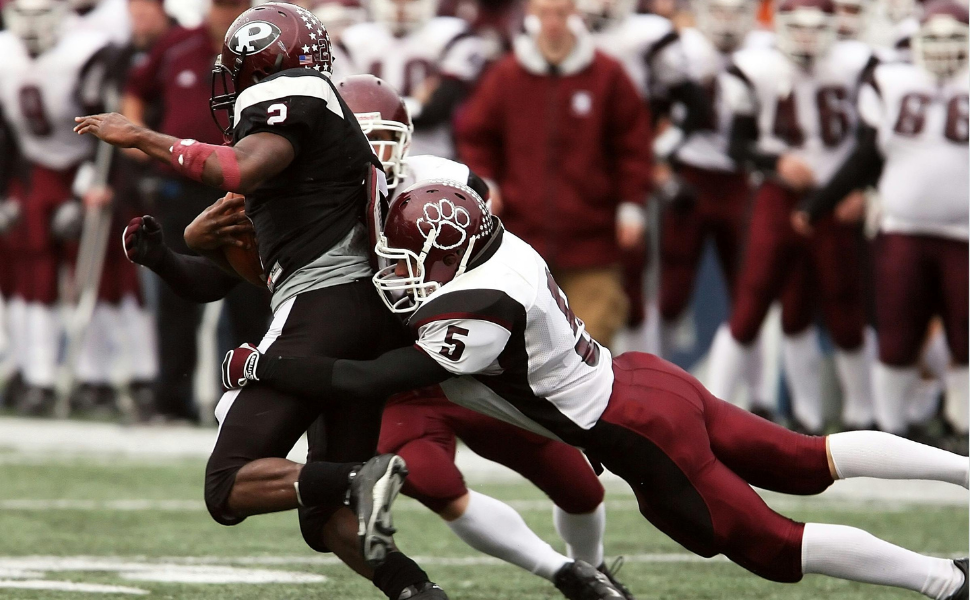What Are the Most Common Football Injuries?

American football involves intense body confrontations between players. Players routinely tackle each other at high speeds on the field during the game. This setup where powerful impacts regularly occur can easily lead to injuries, especially on the lower body.
So what are the most common football injuries? The answers include ankle and knee injuries. Rapid cuts, starts, stops, and changes of direction subject ankles and knees to severe torsion and impact. Ankle sprains, ACL tears, and other joint issues can arise and plague players. It it thus important to understand these injuries as well as to promote preventative measures and recovery protocols for player safety.

What Are the Most Common Football Injuries?
Football puts extraordinary stress on the lower extremities. Repeated impacts and awkward landings can damage weak points over time. It may lead to:
- Ankle Sprains
Ankle sprains are unfortunately very common among football athletes. Ankle joints must endure substantial pressure during cutbacks, starts, and stops. It leaves the ankles unstable and prone to ankle sprains from accidental rolls. Ankle sprains often result from an awkward step or lateral twist and can sideline athletes for several weeks if not properly treated and rehabilitated.
- Jones Fractures
Jones fractures involve the fifth metatarsal bone of the foot. When the bone absorbs excessive stress from unexpected torques and blows, it may crack under duress. Aggressive lateral movements and repeated overuse are often the causes. Its symptoms include pain, swelling, bruising, etc.
- Achilles Tendinitis
Overuse and repetitive stress inflame the tendon connecting the calf to the heel. Changing directions abruptly or accelerating from a stopped position increases the risk. Persistent microtrauma builds until intense inflammation and stiffness hinder movement and performance.
- ACL Injury
- Meniscus Tears
The cushioning meniscus located in the knee covers risk when football players plant and pivot aggressively on that leg. The fibrous cartilage buffers bone on the bone but becomes vulnerable to splitting apart upon excessive impact or twisting.
- Patellar Tendinitis
This refers to the injury of the patellar tendon just below the kneecap due to repetitive jumping, kicking, and running. The pain can be subtle at first but only worsens if not taken care of. It eventually interferes with daily movements such as walking and riding bicycles.

Knee Brace and Ankle Brace: An Effective Prevention Method
Football subjects the lower extremities to substantial repetitive stress that places joints at risk. Fortunately, wearing a quality knee brace and an ankle brace for football can provide crucial protection. These accessories stabilize vulnerable areas and absorb impact forces during sports. The key aspects that make them effective include:
- Joint Stabilization
Ankle and knee braces help stabilize joints by aligning the ankle, shin, thigh or knee, calf, and hamstring in their proper positioning. They firmly hold different segments of legs together. This prevents any unwanted gapping, shifting, or rotational deviations that could damage ligaments and joints during plays.
- Impact Absorption
These sports accessories absorb impact through technical components like cushioned frameworks, molded curves, and flexibility. Shocks transferred to muscles, tendons, and bones are notably lessened through braces’ impact dissipation abilities.
- Limit Excessive Movement
Limiting excessive movement is key to preventing injuries. Knee and ankle braces do just that. By stabilizing joints and absorbing impact, they correspondingly limit uncontrolled or potentially compromising ranges of motion under pressure. Fast cuts and jukes essential to football are still possible within a safe zone of movement.
Quality Ankle and Knee Braces by Fivali
Fivali is a professional sports brace brand with several years of experience. At Fivali, we are committed to empowering active lifestyles without pain. We provide superior yet affordable braces globally. Through our ingenious designs and high-performance materials, we ensure worry-free movement. Two of our offerings are:
Fivali Ankle Sleeve 2 Pack FAR03
The Fivali Ankle Sleeve 2 Pack FAR03 offers lightweight ankle support for football players. Its breathable fabric design keeps ankles cool and comfortable while performing. Its top characteristics include:
- The ankle brace integrates soft silicone dots proven to securely cling to skins, keeping ankles well placed
- Can be stretched multi-directionally, permitting unconstrained sprinting, jumping, landing, or pivoting
- Crafted as a single piece rather than parts, there are no interruptive seams – just uniform compression wrapped fully around ankles for robust coverage.
- A softly padded layer at the Achilles protects this sensitive area from shoe friction or blisters.
- Light fabrics allow players to move as freely as bare ankles while delivering dependable protection
Fivali Football Sport Knee Sleeve FKR12
Our FKR12 knee brace for football utilizes a breathable 3D woven fabric with cushioned padding to keep knees comfortable during contact sports. The key features that make it a top choice for football players include:
- A sweat-wicking 3D weave pulls humidity away from the skin for drier comfort even in the heat
- Reinforced EVA in front absorbs blows to keep patellas protected game after game
- A perimeter strip of no-slip silicone stays locked around knees throughout rapid cuts or tackles
- Seamless compression and minimalist design allow athletes to perform without hindrance
- Breathing fabric incorporates stretch for the perfect hug without distraction or pressure points
- Lightweight yet durable build offers the best knee support for football, facilitating injury-free, high-impact play
What Else Can You Do to Avoid Injuries
In addition to wearing knee and ankle braces, it’s also important to learn other ways of injury prevention. A holistic regimen best maintains player health in the long run. Beyond equipment, focusing on regular training, flexibility routines, and nutrition helps bodies perform at their peak safely.
- Regular Physical Training
Regular strength and conditioning exercises build powerful yet resilient muscles ideally suited for football. Targeted full-body workouts both in and out of season reinforce joints, reduce swelling, and better prepare one’s physique to withstand pounding on the field.
- Stretch and Warm-up
Taking the time to gradually increase blood flow and loosen muscles before playing is key. Stretching and warming up eliminate tightness to allow freer movement and full range of motion without risk of strain. Cool-downs and stretches after are also needed.
- Eat a Balanced Diet
Focusing on lean proteins, vitamins, minerals, and carbohydrates from whole foods gives athletes energy for practice and games while promoting muscle recovery, repair, and growth. What you eat directly impacts performance as well as injury avoidance throughout the season.

There are several answers to the question, ‘What are the most common football injuries?’ The physically demanding nature of this sport subjects players to repetitive stresses that increase injury risks, particularly to the lower extremities. Ankle sprains, jones fractures, ACL injury, etc., are quite common. Wearing quality braces from brands like Fivali helps maximize protection, support joints, and absorb impacts – keeping athletes in top form. In addition to these, prudent training, stretching, and nutrition practices are key to injury prevention. These healthy practices reinforce the entire body for any position. Multi-faceted prevention prioritizing both equipment and lifestyle best serves those seeking longevity in America’s beloved sport. Browse our range of injury-prevention solutions for various sports and positions.













